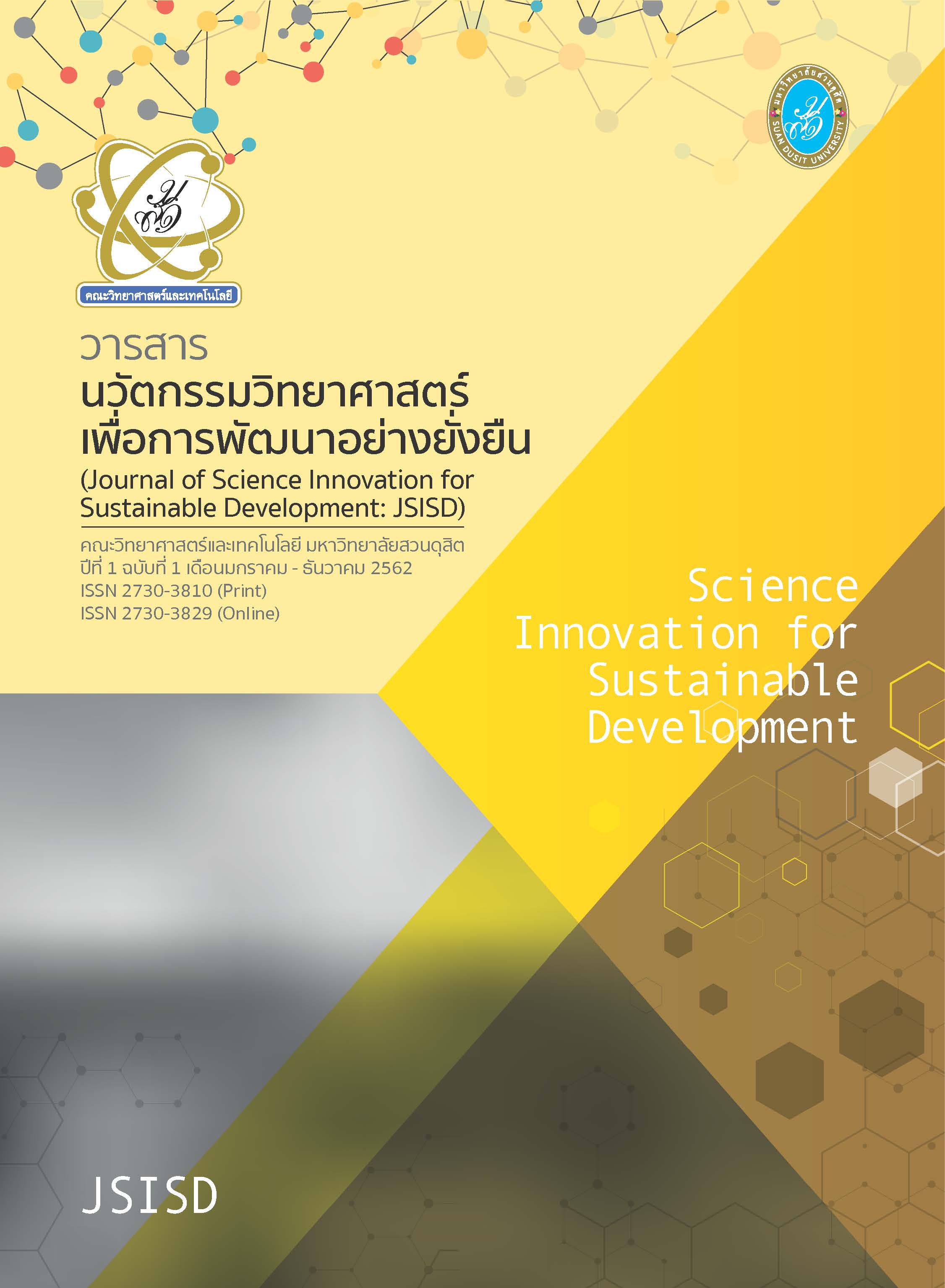Quantitative thin layer chromatographic analysis of rosmarinic acid as a chemical marker in Perilla frutescens leaves ปาริชาติ หงษ์สิงห์ ชนิดา พลานุเวช* และ นิจศิริ เรืองรังษี
Main Article Content
บทคัดย่อ
พัฒนาการวิเคราะห์ที่ง่าย รวดเร็ว และเหมาะสม ในการหาปริมาณกรดโรสมารินิกในใบงาขี้ม้อน (Perilla frutescens (L.) Britton) โดยใช้วิธีทินเลเยอร์โครมาโทกราฟี-เด็นซิโทเมทรีและวิธีทินเลเยอร์โครมาโทกราฟีโดยวิเคราะห์ภาพถ่าย กรดโรสมารินิกจัดเป็นตัวบ่งชี้ทางเคมีในสารสกัดใบงาขี้ม้อน ซึ่งใช้เสริมสร้างคุณภาพวัตถุดิบสมุนไพรของใบงาขี้ม้อนได้ เก็บใบงาขี้ม้อนจากแหล่งต่างๆ 15 แหล่งในประเทศไทย ทำการแยกวิเคราะห์สารด้วยแผ่นทีแอลซีเคลือบซิลิกาเจล 60 จีเอฟ 254 โดยปรับใช้สองวัฏภาคเคลื่อนที่ในการศึกษานี้ คือ โทลูอีน-คลอโรฟอร์ม-อะซีโทน-กรดฟอร์มิก (5:4:1:0.2) เป็นวัฏภาคเคลื่อนที่ลำดับที่หนึ่ง และโทลูอีน-เอทธิล อะซีเตท-กรดฟอร์มิก (5:4:1) เป็นวัฏภาคเคลื่อนที่ลำดับที่สอง วิธีทินเลเยอร์โครมาโทกราฟี-เด็นซิโทเมทรีและวิธีทินเลเยอร์โครมาโทกราฟีโดยวิเคราะห์ภาพถ่ายที่พัฒนาขึ้นสำหรับวิเคราะห์ปริมาณกรดโรสมารินิกในใบงาขี้ม้อนให้ค่าความจำเพาะ ความเที่ยง ความแม่นจากการทำซ้ำในวันเดียวกันและระหว่างวัน ขีดจำกัดของการตรวจพบ ขีดจำกัดของการหาปริมาณ และค่าความคงทนที่ถูกต้อง การวิเคราะห์กรดโรสมารินิกด้วยเทคนิคทินเลเยอร์โครมาโทกราฟีทั้งสองวิธี พบว่ามีปริมาณเท่ากับ 2.504 ± 1.631 และ 2.485 ± 1.606 กรัมต่อ 100 กรัม โดยน้ำหนักแห้งตามลำดับ วิธีทินเลเยอร์โครมาโทกราฟีโดยวิเคราะห์ภาพถ่ายอาจเป็นทางเลือกหนึ่งในการหาปริมาณของกรดโรสมารินิกในใบ Perilla frutescens
Article Details

อนุญาตภายใต้เงื่อนไข Creative Commons Attribution-NonCommercial-NoDerivatives 4.0 International License.
ลิขสิทธิ์ต้นฉบับที่ได้รับการตีพิมพ์ในวารสารนวัตกรรมวิทยาศาสตร์เพื่อการพัฒนาอย่างยั่งยืนถือเป็นกรรมสิทธิ์ของคณะวิทยาศาสตร์และเทคโนโลยี มหาวิทยาลัยสวนดุสิต ห้ามผู้ใดนำข้อความทั้งหมดหรือบางส่วนไปพิมพ์ซ้ำ เว้นแต่จะได้รับอนุญาตอย่างเป็นลายลักษณ์อักษรจากคณะวิทยาศาสตร์และเทคโนโลยี มหาวิทยาลัยสวนดุสิต นอกจากนี้ เนื้อหาที่ปรากฎในบทความเป็นความรับผิดชอบของผู้เขียน ทั้งนี้ไม่รวมความผิดพลาดอันเกิดจากเทคนิคการพิมพ์
เอกสารอ้างอิง
Asif, M. (2012). Phytochemical study of polyphenols in Perilla Frutescens as an antioxidant. Avicenna journal of phytomedicine, 2(4), 169–178.
Izumi, Y., Matsumura, A., Wakita, S., Akagi, K. I., Fukuda, H., Kume, T., Akaike, A. (2012). Isolation, identification, and biological evaluation of Nrf2-ARE activator from the leaves of green perilla (Perilla frutescens var. crispa f. viridis). Free Radical Biology and Medicine, 53(4), 669–679.
Natsume, M., Muto, Y., Fukuda, K., Tokunaga, T., & Osakabe, N. (2006). Determination of rosmarinic acid and luteolin in Perilla frutescens Britton (Labiatae). Journal of the Science of Food and Agriculture, 86(6), 897–901. doi:10.1002/jsfa.2432.
Oh, H. A., Park, C. S., Ahn, H. J., Park, Y. S., and Kim, H. M. (2011). Effect of Perilla frutescens var. acuta Kudo and rosmarinic acid on allergic inflammatory reactions. Experimental Biology and Medicine, 236(1), 99–106. doi:10.1258/ebm.2010.010252.
Osakabe, N., Yasuda, A., Natsume, M., Sanbongi, C., Kato, Y., Osawa, T., and Yoshikawa, T. (2002). Rosmarinic acid, a major polyphenolic component of Perilla frutescens, reduces lipopolysaccharide (LPS)-induced liver injury in d-galactosamine (d-GalN)-sensitized mice. Free Radical Biology and Medicine, 33(6), 798–806.
Runtuwene, J., Cheng, K.-C., Asakawa, A., Amitani, H., Amitani, M., Morinaga, A., Inui, A. (2016). Rosmarinic acid ameliorates hyperglycemia and insulin sensitivity in diabetic rats, potentially by modulating the expression of PEPCK and GLUT4. Drug design, development and therapy, 10, 2193–2202.
Saklani, S., Kothiyal, S., and Gautam, A. K. (2011). Phytochemical investigation and contribution of perilla frutescence as spices in traditional health care system. International Journal of Pharmacy and Technology, 3, 3543–3554.
Senol, F. S., Ślusarczyk, S., Matkowski, A., Pérez-Garrido, A., Girón-Rodríguez, F., Cerón-Carrasco, J. P., and Orhan, I. E. (2017). Selective in vitro and in silico butyrylcholinesterase inhibitory activity of diterpenes and rosmarinic acid isolated from Perovskia atriplicifolia Benth. and Salvia glutinosa L. Phytochemistry, 133, 33–44.
Singh, S. K., Kole, P. C., Misra, A. K., Roy, S., Arya, L., Verma, M., and Singh, R. (2017). Characterization of Perilla frutescens (Linn.) Britt based on morphological, biochemical and STMS markers. Industrial Crops and Products, 109, 773–785.
The International Council for Harmonisation of Technical Requirements for Pharmaceuticals for Human Use. (2005). Validation of analytical procedures: text and methodology Q2(R1). Retrieved from https://www.ich.org/fileadmin/Public_Web_Site/ICH_Products/Guidelines/ Quality/Q2_R1/Step4/Q2_R1__Guideline.pdf.
World Health Oraganization. (2017). WHO guidelines for selecting marker substances of herbal origin for quality control of herbal medicines. Retrieved from http://apps.who.int/medicinedocs/en/m/abstract/Js23240en/
Yu, H., Qiu, J. F., Ma, L. J., Hu, Y. J., Li, P., and Wan, J. B. (2017). Phytochemical and phytopharmacological review of Perilla frutescens L. (Labiatae), a traditional edible-medicinal herb in China. Food and Chemical Toxicology, 108, 375–391.
Zdařilová, A., Svobodová, A., Šimánek, V., and Ulrichová, J. (2009). Prunella vulgaris extract and rosmarinic acid suppress lipopolysaccharide-induced alteration in human gingival fibroblasts. Toxicology in Vitro, 23(3), 386–392.


